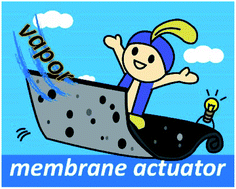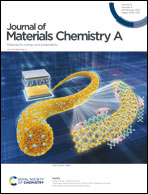Controllable porous membrane actuator by gradient infiltration of conducting polymers†
Abstract
Organic solvent-driven soft actuators are typically fabricated by building up a structural anisotropy across the cross-section of actuators, but the gradient structures often require a sophisticated preparation process and lack mechanical strength for repeated use. Herein, we demonstrate a simple and straightforward approach to making a porous membrane actuator by coating conducting polymers on a commercial membrane via vapor phase polymerization. The infiltration coating of the conducting polymer induces a gradient structure across the membrane, triggering a fast and reversible actuation behavior in organic solvents and their vapors. Furthermore, the conducting polymer layers provide structural conductivity and robustness on the membrane actuator. With the assistance of liquid and tape masking, the membrane actuator can be patterned with the conducting polymer for biomimetic motions in response to solvent molecules. With a view to commercial availability and synthetic simplicity, a large-scale membrane actuator could be fabricated without compromising the performance. As a proof-of-concept, the membrane actuators are showcased in an electrical switch and a soft gripper working in a chemical spill, proving the feasibility for practical applications.



 Please wait while we load your content...
Please wait while we load your content...